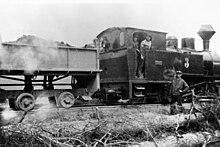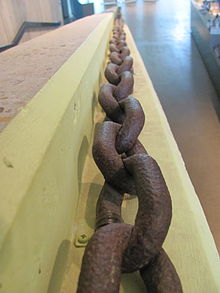Messel mine railways
The Messel mine railways were different railway systems that were used during the period of active mining in the Messel mine to transport the mining products and overburden .
requirements
In the Messel Pit was from the 1870s to 1971 bituminous mudstone (: colloquially oil shale ) and mined since 1884 charred to petroleum products to win. The pit and the Schwelerei were connected to the Messel train station and the Darmstadt-Aschaffenburg railway line of the Hessian Ludwig Railway (later: the Prussian-Hessian Railway Community and its legal successors) via a siding .
Horse tram
The initial removal of the mining product and the overburden with horse-drawn vehicles soon showed insufficient capacity. Therefore, a horse-drawn railway with a gauge of 600 mm was built. Uphill their wagons were pulled by horses , downhill they rolled freely and were braked with grinding boards at the end of the slope . This conveyor line was called the "taxiway". Were used cars from solid oak with a capacity of half a cubic meter, which were built so stable that they were used until about 1960th
Chain lift
After the capacity of this system was exhausted due to increasing delivery rates, the traction for the wagons was switched to a mechanical chain conveyor from 1889 . Its drive station was located directly next to the processing plant on the edge of the pit. Both were powered by gas engines. The decision for this technology was made because the oil shale is flammable and the use of coal-fired steam locomotives was therefore too dangerous. The chain lift proved its worth so that the system was constantly expanded. Finally, there were two double-track conveyor lines, each with branches, a section from the processing plant to a dump where oil shale that was not smoldering was deposited and a section between the boiler house and the smoldering on the one hand and the slag dump on the other. Iron tilting lorries were used here, as the smoldering residue was taken out of the ovens to be tipped off at temperatures of up to 300 degrees Celsius . 80 cm wide conveyor belts have been in use since 1950 , replacing the chain conveyors by 1963.
600 mm track
Since the 1890s, the non-flammable dead rock was driven to the spoil dump on a 600 mm narrow-gauge railway operated by steam locomotives. This was initially west of the pit. Wooden wagons with a capacity of approx. One cubic meter, which had removable side walls and had to be shoveled empty by hand, were used for this.
This railway initially had short distances and slight gradients. In 1924 a new spoil dump was set up northeast of the mine. To do this, the train had to be led around the pit to the north, a 1.5 km long stretch.
900 mm track
In 1932 the system was 900 mm umgespurt . In addition, 5 km of tracks were laid in the area of the waste dump and a depot was set up south of it. Due to the increasing depth of the excavation, the pit had to be redeveloped on the railway side. This took place from 1940 onwards from the south. The difference in height was overcome over several excavation levels with a saw drive over the last five switchbacks . This development was connected to the existing system at the depot, which mainly ran north of the pit. At the end of the Second World War , the fleet consisted of nine steam locomotives, 64 iron wagons and a few special vehicles. The mine railway had its own repair workshop for the vehicles and a track construction workshop.
End of mine railway operations
The steadily increasing mining depth made rail operations over the hairpin bends on longer routes more and more complex. The good experience with transporting the oil shale with the 80 cm wide conveyor belt was therefore also transferred to the overburden. This enabled a much steeper incline to be overcome over a much shorter route. In 1951 the overburden track was therefore replaced by a 1,100 m long conveyor belt.
literature
- Georg Beeger: Chronicle of the Messel Pit 1884–1964 . In: Stephan Schaal and Ulrich Schneider (eds.): Chronicle of the Messel Pit . Gladenbach 1995. ISBN 3-88343-016-1 , pp. 3-195.
- Manfred Raab: The mine railways in the area of the former Messel pit mineral oil works . In: The railway and its history = series of publications of the district of Darmstadt-Dieburg 2 (Ed .: Georg Wittenberger / Förderkreis Museen und Denkmalpflege Darmstadt-Dieburg). Darmstadt 1985, pp. 92–95.






